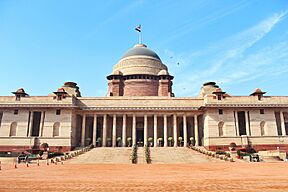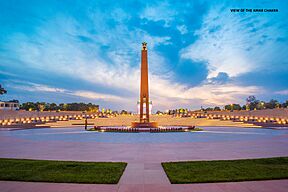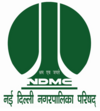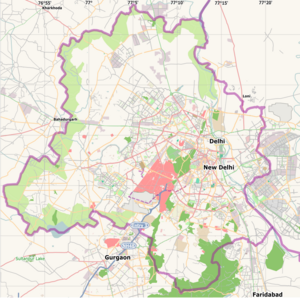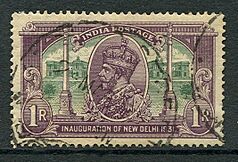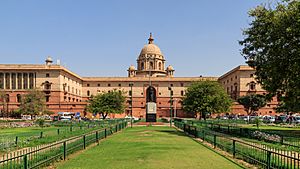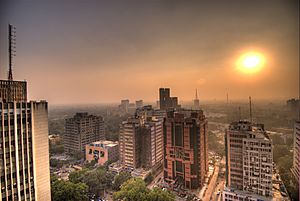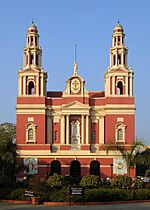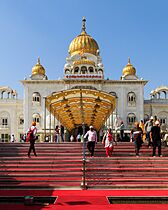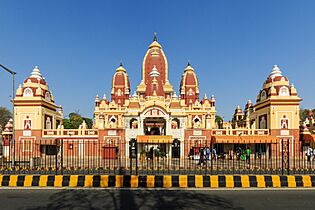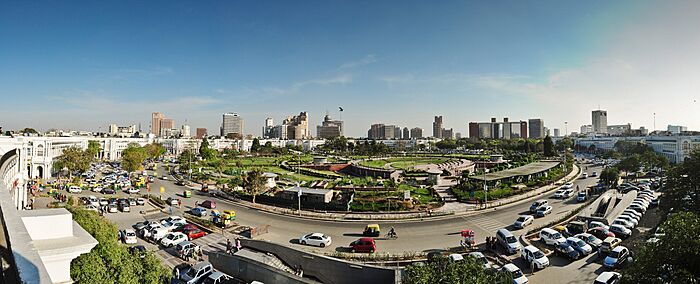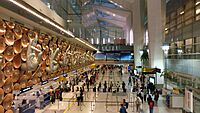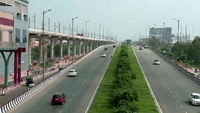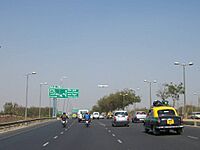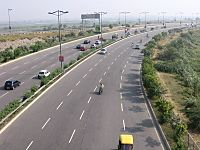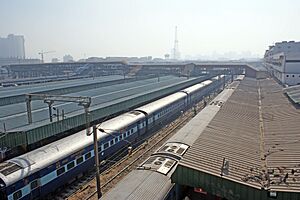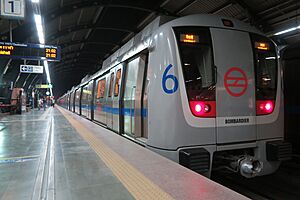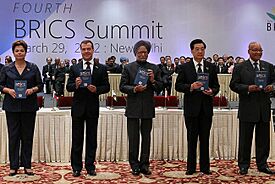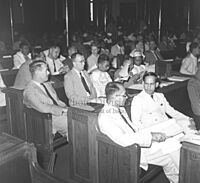New Delhi facts for kids
Quick facts for kids
New Delhi
Naī Dillī
|
||
|---|---|---|
|
Federal capital
|
||
|
Rashtrapati Bhawan
Parliament House
Bharat Mandapam
LIC, Connaught Place
Skyline of Connaught Place
India Gate
National War Memorial
|
||
|
||
| Motto(s):
Śrama ēva jayatē
Labour is victory |
||
| Country | ||
| Union territory | ||
| Lok Sabha constituency | New Delhi | |
| Legislative Assembly | New Delhi | |
| District | New Delhi | |
| Established | 12 December 1911 | |
| Inaugurated | 13 February 1931 | |
| Founded by | George V | |
| Government | ||
| • Type | Municipal Council | |
| • Body | New Delhi Municipal Council | |
| Area | ||
| • Capital city | 42.7 km2 (16.49 sq mi) | |
| Area rank | 10 | |
| Elevation | 216 m (708.62 ft) | |
| Population
(2011)
|
||
| • Capital city | 249,998 | |
| • Rank | 11 | |
| • Density | 5,855/km2 (15,161/sq mi) | |
| • Metro (2018; includes entire urban Delhi + part of NCR) | 28,514,000 | |
| Time zone | UTC+05:30 (IST) | |
| PIN |
110001, 121003, 1220xx, 201313 (New Delhi)
|
|
| Area code(s) | +91-11 | |
| Vehicle registration | DL-2X | |
| International Airport | Indira Gandhi International Airport | |
| Metro line(s) | Yellow Blue Violet Pink Airport Express |
|
New Delhi is the capital city of India. It is a part of the larger National Capital Territory of Delhi. New Delhi is where all three parts of the Government of India are located. This includes the Rashtrapati Bhavan (President's House), Sansad Bhavan (Parliament House), and the Supreme Court.
New Delhi is managed by the NDMC. This area mainly covers a part of the city called Lutyens' Delhi and some nearby places. Even though people often use "Delhi" and "New Delhi" to mean the same thing, they are actually different. New Delhi is a smaller area within the huge city of Delhi. The National Capital Region is even bigger. It includes all of Delhi and other nearby cities like Gurgaon and Noida.
The idea for New Delhi started in 1911. George V, who was the King of the United Kingdom and Emperor of India, laid its foundation stone. British architects Edwin Lutyens and Herbert Baker designed the city. The new capital was officially opened on February 13, 1931.
Contents
History of New Delhi
How New Delhi Was Built
Before December 1911, Calcutta (now Kolkata) was the capital of India under British rule. However, many people in Calcutta started movements against the British. This led the British government to decide to move the capital. They thought it would be easier to rule India from Delhi, which is more central in northern India.
Old Delhi had been an important center for many empires in India's past. So, the British decided to build their new capital near it. King George V announced the shift of the capital to Delhi on December 12, 1911. He also laid the foundation stone for the Viceroy's (ruler's) residence.
Famous British architects, Edwin Lutyens and Herbert Baker, designed much of New Delhi. They started planning in 1912. Construction began after World War I and finished by 1931. The city, often called "Lutyens' Delhi," was officially opened by Viceroy Irwin. Lutyens designed the main government area to show the power of the British Empire.
The architects chose a spot on Raisina Hill for the Rashtrapati Bhawan, which was then called the Viceroy's House. This hill was chosen because it faced the ancient Purana Qila fort. The main road of New Delhi, the Rajpath (King's Way), stretches from India Gate to the Rashtrapati Bhawan. The Secretariat Building and the Parliament House are also located nearby.
To help with construction, a special railway line was built around the Parliament House. This "Imperial Delhi Railway" carried building materials and workers for 20 years. The New Delhi Railway Station opened in 1926. A major shopping area, Connaught Place, was also built. It was finished by 1933 and named after Prince Arthur, the Duke of Connaught.
Many government workers moved to the new capital from other parts of India. Housing areas like Gole Market and Lodhi colony were built for them.
New Delhi After Independence
After India became independent in 1947, New Delhi gained some self-rule. In 1966, Delhi became a union territory. The Constitution (Sixty-ninth Amendment) Act, 1991 officially named it the National Capital Territory of Delhi. This gave the elected government more power, but the central government still handled law and order.
In the 1950s, New Delhi expanded beyond Lutyens' Delhi. A new area called Chanakyapuri was developed. This area was created for embassies, where different countries have their offices and homes for their ambassadors.
Geography and Climate
New Delhi's Location
New Delhi covers an area of about 42.7 square kilometers. It is a small part of the larger Delhi metropolitan area. The city is located on the Indo-Gangetic Plain, so the land is mostly flat. The Delhi Ridge, sometimes called the "Lungs of Delhi," is what's left of the ancient Aravalli Range mountains. New Delhi is near the Yamuna River, but it is a landlocked city, meaning it has no direct access to the sea.
Earthquakes in New Delhi
New Delhi is in a seismic zone-IV. This means it is at risk of earthquakes. The city lies on several fault lines, so small earthquakes happen often. There were more earthquakes between 2011 and 2015, but most were mild.
New Delhi's Weather
New Delhi has a dry-winter humid subtropical climate. This means it has very hot summers and mild, relatively dry winters. Temperatures can go from around 46°C (115°F) in summer to about 10°C (50°F) in winter. Summers are long, lasting from early April to October. The monsoon season, with heavy rainfall, happens in July and August.
The highest temperature ever recorded in New Delhi was 49.9°C (121.8°F) in May 2024. The lowest was -2.2°C (28°F) in January 1967. The city gets about 774.4 mm (30.5 inches) of rain each year. Most of this rain falls during the monsoon months.
| Month | Jan | Feb | Mar | Apr | May | Jun | Jul | Aug | Sep | Oct | Nov | Dec | Year |
|---|---|---|---|---|---|---|---|---|---|---|---|---|---|
| Record high °C (°F) | 32.5 (90.5) |
34.1 (93.4) |
40.6 (105.1) |
45.6 (114.1) |
47.2 (117.0) |
46.7 (116.1) |
45.0 (113.0) |
42.0 (107.6) |
40.6 (105.1) |
39.4 (102.9) |
36.1 (97.0) |
30.0 (86.0) |
47.2 (117.0) |
| Mean maximum °C (°F) | 25.8 (78.4) |
29.5 (85.1) |
35.8 (96.4) |
41.4 (106.5) |
44.3 (111.7) |
43.7 (110.7) |
40.1 (104.2) |
37.4 (99.3) |
37.1 (98.8) |
36.1 (97.0) |
32.2 (90.0) |
27.3 (81.1) |
44.8 (112.6) |
| Mean daily maximum °C (°F) | 20.1 (68.2) |
24.2 (75.6) |
29.9 (85.8) |
36.5 (97.7) |
39.9 (103.8) |
39.0 (102.2) |
35.6 (96.1) |
34.2 (93.6) |
34.1 (93.4) |
33.0 (91.4) |
28.4 (83.1) |
22.8 (73.0) |
31.4 (88.5) |
| Daily mean °C (°F) | 14.0 (57.2) |
17.8 (64.0) |
23.1 (73.6) |
29.1 (84.4) |
32.8 (91.0) |
33.3 (91.9) |
31.5 (88.7) |
30.6 (87.1) |
29.7 (85.5) |
26.1 (79.0) |
20.7 (69.3) |
15.7 (60.3) |
25.3 (77.5) |
| Mean daily minimum °C (°F) | 7.5 (45.5) |
10.6 (51.1) |
15.6 (60.1) |
21.3 (70.3) |
25.8 (78.4) |
27.7 (81.9) |
27.5 (81.5) |
26.7 (80.1) |
25.0 (77.0) |
19.5 (67.1) |
13.0 (55.4) |
8.4 (47.1) |
18.9 (66.0) |
| Mean minimum °C (°F) | 3.5 (38.3) |
6.0 (42.8) |
10.7 (51.3) |
16.3 (61.3) |
20.5 (68.9) |
22.2 (72.0) |
24.3 (75.7) |
23.7 (74.7) |
21.9 (71.4) |
15.0 (59.0) |
8.8 (47.8) |
4.5 (40.1) |
3.1 (37.6) |
| Record low °C (°F) | −0.6 (30.9) |
1.6 (34.9) |
4.4 (39.9) |
10.7 (51.3) |
15.1 (59.2) |
17.6 (63.7) |
20.3 (68.5) |
20.7 (69.3) |
16.1 (61.0) |
9.4 (48.9) |
3.9 (39.0) |
0.0 (32.0) |
−0.6 (30.9) |
| Average rainfall mm (inches) | 19.1 (0.75) |
21.3 (0.84) |
17.4 (0.69) |
16.3 (0.64) |
30.7 (1.21) |
74.1 (2.92) |
209.7 (8.26) |
233.1 (9.18) |
123.5 (4.86) |
15.1 (0.59) |
6.0 (0.24) |
8.1 (0.32) |
774.4 (30.5) |
| Average rainy days | 1.7 | 1.5 | 1.7 | 1.0 | 2.7 | 4.8 | 9.7 | 10.2 | 5.5 | 0.8 | 0.4 | 0.6 | 40.6 |
| Average relative humidity (%) (at 17:30 IST) | 57 | 46 | 37 | 25 | 28 | 43 | 63 | 68 | 60 | 47 | 52 | 59 | 49 |
| Average dew point °C (°F) | 8 (46) |
11 (52) |
14 (57) |
14 (57) |
18 (64) |
22 (72) |
26 (79) |
25 (77) |
23 (73) |
18 (64) |
14 (57) |
10 (50) |
17 (62) |
| Mean monthly sunshine hours | 220.1 | 223.2 | 248.0 | 276.0 | 285.2 | 219.0 | 179.8 | 176.7 | 219.0 | 260.4 | 246.0 | 220.1 | 2,773.5 |
| Mean daily sunshine hours | 7.1 | 7.9 | 8.0 | 9.2 | 9.2 | 7.3 | 5.8 | 5.7 | 7.3 | 8.4 | 8.2 | 7.1 | 7.6 |
| Mean daily daylight hours | 10.6 | 11.2 | 12.0 | 12.9 | 13.6 | 13.9 | 13.8 | 13.1 | 12.3 | 11.5 | 10.7 | 10.3 | 12.2 |
| Percent possible sunshine | 67 | 71 | 67 | 71 | 68 | 53 | 42 | 44 | 59 | 73 | 77 | 69 | 63 |
| Average ultraviolet index | 3 | 5 | 6 | 7 | 9 | 9 | 8 | 7 | 6 | 5 | 4 | 3 | 6 |
| Source 1: India Meteorological Department (sun 1971–2000); Time and Date (dewpoints, 2005–2015) Revised Rainfall data | |||||||||||||
| Source 2: Météo Climat (mean temperature 1991-2020) Weather Atlas (UV Index) (Daylight) | |||||||||||||
| Average Barometric Pressure & Wind Speed of Delhi | |||||||||||||
|---|---|---|---|---|---|---|---|---|---|---|---|---|---|
| Month | January | February | March | April | May | June | July | August | September | October | November | December | Year |
| Average Atmospheric pressure milibars (inHg) | 1,017.0 millibars (30.03 inHg) | 1,014.5 millibars (29.96 inHg) | 1,010.6 millibars (29.84 inHg) | 1,005.4 millibars (29.69 inHg) | 1,000.5 millibars (29.54 inHg) | 996.7 millibars (29.43 inHg) | 996.9 millibars (29.44 inHg) | 999.4 millibars (29.51 inHg) | 1,003.4 millibars (29.63 inHg) | 1,009.6 millibars (29.81 inHg) | 1,013.6 millibars (29.93 inHg) | 1,016.1 millibars (30.01 inHg) | 1,007.0 millibars (29.74 inHg) |
| Average Wind Speed kilometres per hour (mph) | 8.3 kilometres per hour (5.2 mph) | 9.4 kilometres per hour (5.8 mph) | 9.5 kilometres per hour (5.9 mph) | 10.0 kilometres per hour (6.2 mph) | 10.2 kilometres per hour (6.3 mph) | 10.6 kilometres per hour (6.6 mph) | 9.5 kilometres per hour (5.9 mph) | 8.8 kilometres per hour (5.5 mph) | 8.3 kilometres per hour (5.2 mph) | 6.7 kilometres per hour (4.2 mph) | 7.6 kilometres per hour (4.7 mph) | 7.7 kilometres per hour (4.8 mph) | 8.9 kilometres per hour (5.5 mph) |
| Month | Jan | Feb | Mar | Apr | May | Jun | Jul | Aug | Sep | Oct | Nov | Dec | Year |
|---|---|---|---|---|---|---|---|---|---|---|---|---|---|
| Record high °C (°F) | 31.0 (87.8) |
35.7 (96.3) |
41.3 (106.3) |
45.3 (113.5) |
48.4 (119.1) |
48.0 (118.4) |
45.7 (114.3) |
43.2 (109.8) |
40.8 (105.4) |
40.7 (105.3) |
36.4 (97.5) |
30.4 (86.7) |
48.4 (119.1) |
| Mean maximum °C (°F) | 26.1 (79.0) |
29.5 (85.1) |
36.4 (97.5) |
42.6 (108.7) |
45.3 (113.5) |
44.9 (112.8) |
40.9 (105.6) |
38.2 (100.8) |
37.8 (100.0) |
36.8 (98.2) |
32.7 (90.9) |
27.4 (81.3) |
45.3 (113.5) |
| Mean daily maximum °C (°F) | 19.9 (67.8) |
24.1 (75.4) |
30.0 (86.0) |
37.1 (98.8) |
40.7 (105.3) |
39.6 (103.3) |
36.0 (96.8) |
34.5 (94.1) |
34.4 (93.9) |
33.3 (91.9) |
28.3 (82.9) |
22.7 (72.9) |
31.7 (89.1) |
| Daily mean °C (°F) | 13.3 (55.9) |
17.6 (63.7) |
23.4 (74.1) |
29.8 (85.6) |
33.6 (92.5) |
33.5 (92.3) |
31.2 (88.2) |
30.2 (86.4) |
29.8 (85.6) |
26.6 (79.9) |
20.7 (69.3) |
14.8 (58.6) |
25.4 (77.7) |
| Mean daily minimum °C (°F) | 7.3 (45.1) |
10.6 (51.1) |
15.4 (59.7) |
21.7 (71.1) |
26.4 (79.5) |
27.9 (82.2) |
27.4 (81.3) |
26.4 (79.5) |
24.9 (76.8) |
19.9 (67.8) |
13.7 (56.7) |
9.0 (48.2) |
19.2 (66.6) |
| Mean minimum °C (°F) | 3.6 (38.5) |
6.2 (43.2) |
9.7 (49.5) |
15.3 (59.5) |
20.8 (69.4) |
22.3 (72.1) |
24.1 (75.4) |
23.3 (73.9) |
21.7 (71.1) |
15.6 (60.1) |
9.0 (48.2) |
4.6 (40.3) |
3.3 (37.9) |
| Record low °C (°F) | −2.2 (28.0) |
−1.6 (29.1) |
3.4 (38.1) |
8.6 (47.5) |
14.6 (58.3) |
19.8 (67.6) |
17.8 (64.0) |
20.2 (68.4) |
13.6 (56.5) |
9.9 (49.8) |
2.1 (35.8) |
−1.3 (29.7) |
−2.2 (28.0) |
| Average rainfall mm (inches) | 18.1 (0.71) |
19.3 (0.76) |
15.2 (0.60) |
13.6 (0.54) |
30.2 (1.19) |
68.8 (2.71) |
205.7 (8.10) |
214.2 (8.43) |
109.5 (4.31) |
12.7 (0.50) |
5.5 (0.22) |
6.4 (0.25) |
719.2 (28.32) |
| Average rainy days | 1.4 | 1.6 | 1.4 | 1.2 | 2.7 | 4.0 | 8.9 | 9.4 | 5.0 | 0.8 | 0.4 | 0.4 | 37.2 |
| Average relative humidity (%) (at 17:30 IST) | 56 | 48 | 36 | 24 | 25 | 42 | 62 | 67 | 59 | 43 | 44 | 54 | 47 |
| Source 1: India Meteorological Department | |||||||||||||
| Source 2: Tokyo Climate Center (mean temperatures 1991–2020) | |||||||||||||
| Climate data for New Delhi (Ayanagar) 1971–2020, extremes 1967–present | |||||||||||||
|---|---|---|---|---|---|---|---|---|---|---|---|---|---|
| Month | Jan | Feb | Mar | Apr | May | Jun | Jul | Aug | Sep | Oct | Nov | Dec | Year |
| Record high °C (°F) | 29.7 (85.5) |
33.2 (91.8) |
40.6 (105.1) |
45.0 (113.0) |
47.6 (117.7) |
47.0 (116.6) |
44.8 (112.6) |
42.7 (108.9) |
41.0 (105.8) |
39.4 (102.9) |
36.4 (97.5) |
30.2 (86.4) |
47.4 (117.3) |
| Mean maximum °C (°F) | 25.2 (77.4) |
29.4 (84.9) |
36.2 (97.2) |
42.8 (109.0) |
45.9 (114.6) |
45.6 (114.1) |
41.5 (106.7) |
38.3 (100.9) |
37.2 (99.0) |
36.2 (97.2) |
32.2 (90.0) |
27.7 (81.9) |
46.2 (115.2) |
| Mean daily maximum °C (°F) | 19.2 (66.6) |
24.3 (75.7) |
30.7 (87.3) |
36.8 (98.2) |
41.2 (106.2) |
40.5 (104.9) |
35.7 (96.3) |
34.3 (93.7) |
34.2 (93.6) |
33.4 (92.1) |
28.3 (82.9) |
22.2 (72.0) |
31.7 (89.1) |
| Mean daily minimum °C (°F) | 7.7 (45.9) |
11.0 (51.8) |
15.4 (59.7) |
21.0 (69.8) |
25.5 (77.9) |
27.1 (80.8) |
26.5 (79.7) |
25.8 (78.4) |
24.2 (75.6) |
19.5 (67.1) |
14.2 (57.6) |
8.3 (46.9) |
18.9 (66.0) |
| Mean minimum °C (°F) | 3.6 (38.5) |
6.8 (44.2) |
10.5 (50.9) |
16.3 (61.3) |
19.7 (67.5) |
20.6 (69.1) |
22.8 (73.0) |
23.1 (73.6) |
21.5 (70.7) |
14.5 (58.1) |
9.8 (49.6) |
3.2 (37.8) |
2.9 (37.2) |
| Record low °C (°F) | −1.3 (29.7) |
0.0 (32.0) |
3.8 (38.8) |
8.4 (47.1) |
13.8 (56.8) |
18.0 (64.4) |
19.8 (67.6) |
21.3 (70.3) |
14.0 (57.2) |
9.4 (48.9) |
3.2 (37.8) |
−0.5 (31.1) |
−1.3 (29.7) |
| Average rainfall mm (inches) | 18.0 (0.71) |
19.8 (0.78) |
21.6 (0.85) |
10.7 (0.42) |
31.1 (1.22) |
69.9 (2.75) |
182.2 (7.17) |
188.4 (7.42) |
106.1 (4.18) |
13.8 (0.54) |
2.1 (0.08) |
5.4 (0.21) |
669.1 (26.33) |
| Average rainy days | 1.6 | 1.6 | 2.1 | 1.0 | 2.8 | 4.5 | 8.5 | 8.6 | 4.7 | 0.6 | 0.3 | 0.4 | 36.7 |
| Average relative humidity (%) (at 17:30 IST) | 64 | 52 | 40 | 26 | 24 | 37 | 64 | 68 | 63 | 50 | 52 | 58 | 51 |
| Source: India Meteorological Department February record high | |||||||||||||
| Climate data for New Delhi (Delhi Ridge) 1991–2020, extremes 1971–present | |||||||||||||
|---|---|---|---|---|---|---|---|---|---|---|---|---|---|
| Month | Jan | Feb | Mar | Apr | May | Jun | Jul | Aug | Sep | Oct | Nov | Dec | Year |
| Record high °C (°F) | 27.5 (81.5) |
34.2 (93.6) |
40.9 (105.6) |
45.7 (114.3) |
47.5 (117.5) |
47.9 (118.2) |
42.5 (108.5) |
40.4 (104.7) |
38.4 (101.1) |
38.4 (101.1) |
34.2 (93.6) |
29.8 (85.6) |
47.9 (118.2) |
| Mean maximum °C (°F) | 24.4 (75.9) |
29.6 (85.3) |
36.4 (97.5) |
42.8 (109.0) |
45.7 (114.3) |
44.8 (112.6) |
40.4 (104.7) |
37.7 (99.9) |
36.8 (98.2) |
36.4 (97.5) |
32.5 (90.5) |
27.2 (81.0) |
45.9 (114.6) |
| Mean daily maximum °C (°F) | 19.0 (66.2) |
24.4 (75.9) |
31.0 (87.8) |
37.0 (98.6) |
40.7 (105.3) |
39.8 (103.6) |
35.1 (95.2) |
33.9 (93.0) |
34.0 (93.2) |
33.4 (92.1) |
28.0 (82.4) |
22.5 (72.5) |
31.4 (88.5) |
| Mean daily minimum °C (°F) | 8.7 (47.7) |
12.1 (53.8) |
16.8 (62.2) |
22.0 (71.6) |
25.9 (78.6) |
27.0 (80.6) |
26.1 (79.0) |
25.5 (77.9) |
24.1 (75.4) |
20.3 (68.5) |
15.1 (59.2) |
9.9 (49.8) |
19.2 (66.6) |
| Mean minimum °C (°F) | 5.4 (41.7) |
9.0 (48.2) |
12.0 (53.6) |
17.4 (63.3) |
20.7 (69.3) |
21.3 (70.3) |
22.7 (72.9) |
23.2 (73.8) |
21.5 (70.7) |
17.0 (62.6) |
11.5 (52.7) |
5.3 (41.5) |
4.7 (40.5) |
| Record low °C (°F) | 1.5 (34.7) |
7.0 (44.6) |
10.2 (50.4) |
11.6 (52.9) |
14.2 (57.6) |
16.7 (62.1) |
21.0 (69.8) |
21.6 (70.9) |
19.0 (66.2) |
12.4 (54.3) |
9.7 (49.5) |
3.5 (38.3) |
1.5 (34.7) |
| Average rainfall mm (inches) | 20.1 (0.79) |
19.5 (0.77) |
17.8 (0.70) |
7.6 (0.30) |
34.0 (1.34) |
60.7 (2.39) |
190.1 (7.48) |
190.2 (7.49) |
119.3 (4.70) |
26.5 (1.04) |
2.1 (0.08) |
6.1 (0.24) |
694 (27.32) |
| Average rainy days | 1.9 | 1.5 | 1.3 | 1.1 | 2.4 | 3.9 | 8.3 | 9.4 | 5.2 | 0.5 | 0.3 | 0.5 | 36.3 |
| Average relative humidity (%) (at 17:30 IST) | 66 | 54 | 41 | 29 | 31 | 44 | 71 | 76 | 68 | 55 | 54 | 62 | 55 |
| Source: India Meteorological Department February record high | |||||||||||||
Air Quality in New Delhi
New Delhi faces serious air pollution challenges. In 2014, the World Health Organization called it the most polluted city globally among those they studied. In 2019, IQAir also named New Delhi the world's most polluted capital city.
To help reduce pollution, the Delhi government tried a special rule in 2015. Cars with odd and even license plate numbers could only drive on certain days. This rule was tried for 15 days. Also, trucks were allowed to enter the city later at night.
The Supreme Court of India also put rules in place to fight pollution. They stopped new registrations for large diesel cars for a while. Taxis in Delhi had to switch to compressed natural gas (CNG). Older transportation vehicles were also banned from entering the capital.
During the COVID-19 pandemic lockdown in India, the air quality improved a lot. This was because many industries were closed. However, in November 2020, New Delhi had its most polluted day of the year. The amount of harmful particles was 14 times higher than the safe limit set by the WHO.
| Month | January | February | March | April | May | June | July | August | September | October | November | December |
|---|---|---|---|---|---|---|---|---|---|---|---|---|
| Average Air quality index | 201-300
(Poor) |
201-300
(Poor) |
101-200
(Moderate) |
101-200
(Moderate) |
101-200
(Moderate) |
101-200
(Moderate) |
51-100
(Satisfactory) |
51-100
(Satisfactory) |
51-100
(Satisfactory) |
401-500
(Severe) |
401-500
(Severe) |
301-400
(Very Poor) |
People and Culture
Population and Languages
| Historical population | ||
|---|---|---|
| Year | Pop. | ±% |
| 1931 | 73,653 | — |
| 1941 | 93,733 | +27.3% |
| 1951 | 276,314 | +194.8% |
| 1961 | 261,545 | −5.3% |
| 1971 | 301,801 | +15.4% |
| 1981 | 273,036 | −9.5% |
| 1991 | 301,297 | +10.4% |
| 2001 | 302,363 | +0.4% |
| 2011 | 257,803 | −14.7% |
| Source: Government of India | ||
In 2011, the New Delhi Municipal Council area had about 250,000 people. Hindi is the most common language spoken in New Delhi. English is also widely used, especially in government and business. New Delhi has a high literacy rate of 89.38%, meaning most people can read and write.
Religions in New Delhi
| Religion in New Delhi (NDMC) | ||||
|---|---|---|---|---|
| Religion | Percent | |||
| Hinduism | 89.82% | |||
| Islam | 4.50% | |||
| Christianity | 2.93% | |||
| Sikhism | 1.97% | |||
| Jainism | 0.42% | |||
| Others | 0.36% | |||
According to the 2011 census, most people in New Delhi (89.8%) follow Hinduism. There are also communities of Muslims (4.5%), Christians (2.9%), and Sikhs (2.0%). Other religions like Jainism, Buddhism, and Judaism are also present.
- Religious buildings in New Delhi
Festivals and Celebrations
New Delhi is a diverse city with many cultures. National holidays are celebrated with great excitement. On Independence Day (August 15), the prime minister of India speaks from the Red Fort. Many people fly kites, which symbolize freedom. The Republic Day Parade on January 26 shows India's rich culture and military strength.
People also celebrate many religious festivals. These include Diwali (festival of light), Holi (festival of colors), Eid ul-Fitr, and Christmas. The Qutub Festival is a cultural event with music and dance performances. Other popular events are the Kite Flying Festival and the International Mango Festival.
Economy and Business
New Delhi is the biggest business city in northern India. It has a high income per person, one of the highest in India. The government and related sectors are major employers.
The city's service industry has grown a lot. This is because many people speak English and are skilled. This has attracted many international companies. Important service industries include information technology, hotels, banking, and tourism.
Connaught Place is one of the largest business centers in North India. It is located in the northern part of New Delhi. Other areas like Barakhamba Road are also important for business.
New Delhi is considered one of the top emerging markets for retail businesses in Asia-Pacific. The city's overall economic activity is ranked high globally.
Famous Places and Gardens
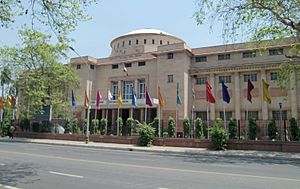
New Delhi has many historic sites and museums. The National Museum started in 1949. It has over 200,000 artworks and artifacts from India and other countries. These items cover more than 5,000 years of history.
The India Gate was built in 1931. It looks like the Arc de Triomphe in Paris. It is a national monument that honors 90,000 Indian soldiers. These soldiers died fighting for the British in World War I and the Third Anglo-Afghan War.
The Rajpath is a grand ceremonial road in New Delhi. It stretches from the Rashtrapati Bhavan to the India Gate. The annual Republic Day parade takes place here every January 26.
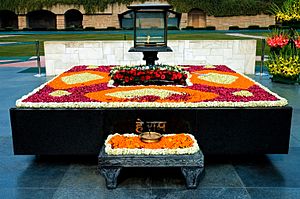
Gandhi Smriti is the place where Mahatma Gandhi spent his last days. He was assassinated there in 1948. Rajghat is where Gandhi was cremated. It is a peaceful memorial by the Yamuna River.
Jantar Mantar is an old observatory in Connaught Place. It was built by Maharaja Jai Singh II of Jaipur. It has 13 special instruments used to study the stars and planets.
New Delhi also has many other museums. These include the Indira Gandhi Memorial Museum, the National Gallery of Modern Art, and the National Rail Museum. A new National War Memorial and Museum is also being built.
The city is known for its beautiful gardens. Some of the largest are Buddha Jayanti Park and the historic Lodi Gardens. There are also lovely gardens around the Presidential Estate and along the Rajpath. The New Delhi Municipal Council area was named the cleanest in North India in 2017.
City Layout and Buildings
Much of New Delhi was designed by Edwin Lutyens. He wanted the city's layout and buildings to show the power of the British Empire. New Delhi is built around two main roads: the Rajpath and the Janpath. The Rajpath goes from the Rashtrapati Bhavan to the India Gate. The Janpath (meaning "Path of the People") crosses the Rajpath at a right angle. Many foreign embassies are located on Shantipath (meaning "Path of Peace"), making it a large diplomatic area.
At the center of the city is the amazing Rashtrapati Bhavan. This building sits on top of Raisina Hill. The Secretariat building, which holds government ministries, is next to the Rashtrapati Bhavan. The Parliament House, designed by Herbert Baker, is also nearby. Connaught Place is a large, round shopping and business area. It was designed to look like the Royal Crescent in England.
Architecture Style
The design of New Delhi was meant to symbolize British power. The architects used ideas from both Hindu and Islamic architecture. This was due to the wishes of Viceroy Hardinge and historians.
It took about 20 years to build the city, starting in 1911. Many parts of New Delhi's buildings use local Indian styles. However, they are still part of a British Classical design. In 2019, the Indian government started a project to redevelop the Central Vista area.
Getting Around New Delhi
Air Travel
The Indira Gandhi International Airport is the main airport for New Delhi. It handles flights from all over India and the world. In 2012–13, over 35 million passengers used the airport. Terminal 3, a large new part of the airport, can handle 37 million more passengers each year.
The Delhi Flying Club started in 1928. It was based at Safdarjung Airport, which was Delhi's only airport until 2001. Now, the club mostly does aircraft maintenance.
The Indira Gandhi International Airport has won awards. It was named the fourth best airport in the world for its size in 2010. In 2015, it was rated the "Best airport in the world" for airports with 25–40 million passengers.
Roads and Highways
New Delhi has one of India's largest bus systems. Buses are run by the Delhi Transport Corporation (DTC). This company has the world's largest fleet of buses that run on compressed natural gas (CNG). New Delhi also has the most registered cars of any city in India. Taxis and auto-rickshaws are also very common.
Some important roads and expressways in New Delhi include:
- Inner Ring Road: A 51 km (32 mi) long circular road. It connects important areas and has many flyovers.
- Outer Ring Road: Another major road that links distant parts of Delhi.
- The Delhi Noida Direct Flyway (DND Flyway): An eight-lane expressway. It connects New Delhi to Noida in Uttar Pradesh.
- The Delhi Gurgaon Expressway: A 28 km (17 mi) expressway. It connects New Delhi to Gurgaon in Haryana.
- The Delhi Faridabad Skyway: An expressway that connects New Delhi to Faridabad in Haryana.
New Delhi is also connected to the rest of India by several National Highways.
Train Travel
New Delhi is a major hub for India's railway system. It is the main office for the Northern Railway. The city has five main railway stations:
- New Delhi railway station
- Delhi Junction
- Hazrat Nizamuddin railway station
- Anand Vihar Terminal
- Sarai Rohilla
The Delhi Ring Railway is a 35 km (22 mi) circular railway network. It runs around Delhi and is part of the city's local train services.
| Station Name | Station Code | Railway Zone | Total Platforms |
|---|---|---|---|
| New Delhi | NDLS | Northern Railway | 16 |
| Delhi Junction | DLI | Northern Railway | 16 |
| Hazrat Nizamuddin | NZM | Northern Railway | 9 |
| Anand Vihar Terminal | ANVT | Northern Railway | 7 |
| Delhi Sarai Rohilla | DEE | Northern Railway | 7 |
Metro System
The Delhi Metro is a fast train system that serves Delhi and nearby cities. It is the 12th largest metro system in the world by length. The Delhi Metro was India's first modern public transport system. It made travel much faster, safer, and more comfortable.
The metro network has 10 different color-coded lines. It serves 255 stations and has a total length of about 348.12 km (216.31 mi). All stations have escalators, elevators, and special tiles for visually impaired people. The metro runs both above ground and underground.
The Delhi Metro is built and run by the Delhi Metro Rail Corporation Limited (DMRC). This is a government-owned company. The DMRC also helps with other metro projects in India and abroad. The Delhi Metro project was led by E. Sreedharan, who is known as the "Metro Man" of India.
Sports in New Delhi
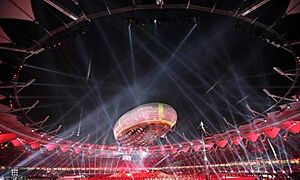
New Delhi has hosted several big sports events. It hosted the 2010 Commonwealth Games and the 1951 Asian Games and 1982 Asian Games. The city also holds the annual Delhi Half Marathon race.
Major sports venues in New Delhi include:
- Jawaharlal Nehru Stadium
- Ambedkar Stadium
- Indira Gandhi Indoor Stadium
- Arun Jaitley Stadium
- Dhyan Chand National Stadium
- Siri Fort Sports Complex
New Delhi is home to several sports teams:
- Delhi Capitals (Cricket)
- Delhi Wizards (Field Hockey)
- Delhi Waveriders (Field Hockey)
- Delhi FC (Football)
- Dabang Delhi (Kabaddi)
| Club | Sport | League | Venue | Span |
|---|---|---|---|---|
| Delhi Capitals | Cricket | IPL | Arun Jaitley Stadium | 2008–present |
| Delhi Wizards | Field hockey | WSH | Dhyan Chand National Stadium | 2011–present |
| Delhi Waveriders | Field hockey | HIL | Dhyan Chand National Stadium | 2013–present |
| Delhi FC | Football | Ambedkar Stadium | 1994–present | |
| Delhi Dashers | Badminton | PBL | DDA Badminton and Squash Stadium | 2015–2019 |
| Dabang Delhi | Kabaddi | PKL | Thyagaraj Sports Complex | 2014–present |
| Indian Aces | Tennis | IPTL | Indira Gandhi Arena | 2014–present |
| Dilli Veer | Wrestling | PWL | K. D. Jadhav Wrestling Stadium | 2015–present |
International Connections
New Delhi is home to many international organizations. The Asian and Pacific Centre for Transfer of Technology, part of the UNESCAP, is based here. Most UN offices in India are also in New Delhi. This includes the UNDP, UNICEF, WHO, and World Bank.
New Delhi also hosts 145 foreign embassies and high commissions. These are offices where other countries have their representatives in India.
International Meetings
New Delhi has hosted several important international meetings:
- The second United Nations Conference on Trade and Development meeting in 1968.
- The 7th NAM Summit in 1983.
- The 4th BRICS Summit in 2012.
- The IBSA Summit in 2015.
- The 5th Global Conference on CyberSpace in 2017.
- The G20 summit in 2023.
Sister Cities
New Delhi has "sister city" relationships with:
Images for kids
See also
 In Spanish: Nueva Delhi para niños
In Spanish: Nueva Delhi para niños


